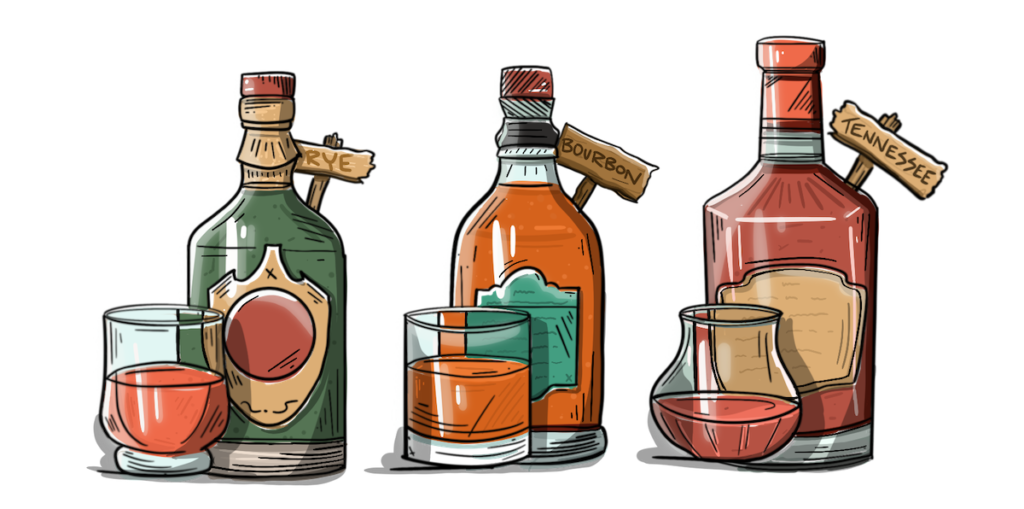What do Scotland, Ireland, Japan, India, Taiwan, and the United States have in common? This isn’t the start of a joke, but a serious question with a clear answer: American Whiskey. For centuries, a rivalry has simmered between Scotland and Ireland over who first crafted whiskey. As these countries competed, this grain spirit aged in oak barrels gradually spread worldwide. Countries like Japan, India, and Taiwan attempted to replicate the production methods of Scottish and Irish whiskey. Some were more successful than others, but none created an entirely new category of this iconic drink.
For centuries, a rivalry has simmered between Scotland and Ireland over who first crafted whiskey. As these countries competed, this grain spirit aged in oak barrels gradually spread worldwide. Countries like Japan, India, and Taiwan attempted to replicate the production methods of Scottish and Irish whiskey. Some were more successful than others, but none created an entirely new category of this iconic drink.
The United States, however, did. A country built by immigrants from diverse cultures, the U.S. created a unique whiskey inspired by distillation knowledge brought from abroad and local grains, particularly corn and rye. Corn fermentation has a long history in America, dating back to the Maya and Aztec civilizations, who produced fermented corn beverages by adding saliva.
With the arrival of colonizers in the 17th and 18th centuries, whiskey production evolved. Immigrants from Scotland, Ireland, and Germany introduced distillation techniques that shaped American whiskey. Over time, unique whiskey types emerged, each with distinct characteristics. Here, we’ll explore these major American whiskey categories and the key terms you’ll see on labels.

BOURBON
In the early 19th century, whiskey made in Bourbon County, Kentucky, was shipped down the Ohio and Mississippi Rivers to New Orleans. Barrels marked “Bourbon” began to define this specific category. It’s worth noting that Bourbon County was named after the French royal family, and Kentucky remains bourbon’s spiritual home with many of the most iconic distilleries.
Early legislation in the 18th century set out the standards for American whiskey production, defining terms like “mash bill,” which refers to the mix of grains used for fermentation. For bourbon, the mash bill must contain at least 51% corn. Additional legislation required new, charred oak barrels for aging, setting the standard for whiskey worldwide.
A popular legend credits Reverend Elijah Craig with creating bourbon. He supposedly charred used barrels to remove fish odors from the wood before storing his spirit, inadvertently adding new flavor profiles. However, historians argue Craig wasn’t the sole “father of bourbon.” Today, bourbon remains a beloved spirit, essential in classic cocktails and popular culture.
To be classified as bourbon, the following requirements must be met:
- Must contain at least 51% corn.
- Distilled to no more than 160 proof (80% ABV).
- Aged in new, charred oak barrels.
- Bottled at a minimum of 80 proof (40% ABV).
- Made in the United States.
TENNESSEE WHISKEY
Often mistaken for bourbon, Tennessee whiskey differs by undergoing charcoal filtration in a process known as the “Lincoln County Process.” This method is mandatory for all Tennessee whiskeys except Benjamin Prichard’s.
To qualify as Tennessee whiskey:
- Must contain at least 51% corn.
- Distilled to no more than 160 proof (80% ABV).
- Aged in new, charred oak barrels.
- Bottled at a minimum of 80 proof (40% ABV).
- Produced in Tennessee.
- Must be filtered through charcoal before aging.
RYE WHISKEY
Another American whiskey category is rye whiskey, known for its spicy flavor profile. Rye whiskey emerged in America’s Northeast in the 17th century, predating bourbon. It even served political purposes in the 18th century, with George Washington distributing his own rye whiskey at gatherings. Washington’s Mount Vernon distillery produced around 11,000 gallons annually, using a mash bill of 60% rye, 35% corn, and 5% malted barley.
Historically, the U.S. faced challenges with whiskey, beginning with a tax on rye whiskey in the late 18th century, sparking the Whiskey Rebellion of 1791-1794. After Prohibition (1920-1933), rye whiskey nearly disappeared but has recently seen a resurgence.
To qualify as rye whiskey:
- Must contain at least 51% rye.
- Distilled to no more than 160 proof (80% ABV).
- Bottled at a minimum of 80 proof (40% ABV).
- Aged in new, charred oak barrels.
- Unlike bourbon and Tennessee whiskey, rye whiskey can be made outside the U.S. and still be called rye whiskey.
CANADIAN WHISKEY
Canadian whiskey has been produced since the 18th century and typically includes corn and rye. Unlike American whiskey, Canada has no specific grain requirements for whiskey production. Although rye was historically prevalent, any whiskey produced in Canada is often called “rye,” even if corn is the primary grain.
WHISKEY LABEL TERMS
You’ll often find these descriptors on whiskey labels:
- Straight: Indicates whiskey aged at least two years. If aged under four years, the age must be listed.
- Sour Mash: Describes a process where part of the fermented mash is reserved and added to the next batch.
- American Whiskey: Often bourbon aged in used or non-charred barrels rather than new, charred oak barrels.
- Bottled-in-Bond: Whiskey produced by one distillery in a single season, aged a minimum of four years in government-bonded warehouses, and bottled at exactly 100 proof (50% ABV). The Bottled-in-Bond Act of 1897 aimed to ensure quality and authenticity.
- Wheat Whiskey: Contains at least 51% wheat in the mash bill.
- Corn Whiskey: Made from a mash bill of at least 80% corn.
- Single Malt American Whiskey: Made entirely from malted barley at a single distillery.
American whiskey is a unique product with a rich history and countless uses in the bar world. In the U.S., both “whiskey” and “whisky” are used, reflecting the diverse origins of those who brought distillation traditions across the Atlantic.





